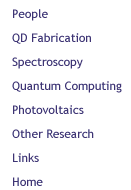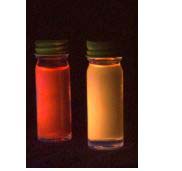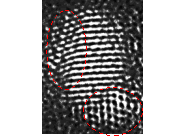|
|
The
University of Queensland
|

Lead sulfide (PbS) based quantum dots have been chosen to study quantum confinement. PbS QD have almost unique characteristics that tend to amplify the quantum confinement effect making it an excellent candidate for quantum dot experiments. However, these characteristics are responsible for the poor fluorescence efficiency of PbS quantum dots. Many groups have tried to improve the fluorescence efficiency of PbS quantum dots using surface state passivation with organic molecules. These approaches have met with little success and in general are not appropriate in PbS quantum dots, due to strong quantum confinement of both electrons and holes. Therefore, a more appropriate technique of epitaxial overgrowth with another semiconductor was considered.
|
Fluorescence activated PbS quantum dots exhibiting both epitaxial (red) and polycrystaline growth |
Cadmium Sulfide (CdS) is a compatible wide band-gap semiconductor, having a similar lattice structure to PbS while presenting a small lattice mismatch of less than 2%. Epitaxial overgrowth of CdS around the PbS quantum dots was conducted in solution using wet chemical methods. Immediately following epitaxial overgrowth, fluorescence can be observed in the colloidal solutions under illumination with a UV lamp. This fluorescence was further increased by an activation step, which involves coating the nanocrystallites with cadmium hydroxide. |
The chemical synthesis was found to produce a wide range of quantum dots with visible fluorescence ranging from deep red to almost white. It is believed that the difference in fluorescence properties relates to the surface quality and morphology of the PbS quantum dots.The chemical conditions that control the formation of these different types of quantum dot are presently under investigation.
| High-resolution transmission electron microscopy (HRTEM) has been used to characterise the structure and shape of the quantum dots. Initial results indicate that the PbS quantum dots grow to a size of approximately 2 nm. However it was also found that epitaxial over-coating with CdS can result in a polycrystalline structure, rather than a uniform over-coating. Control of the epitaxial growth mode, between uniform over-coating and polycrystalline growth, is presently under investigation. |
HRTEM (inverted) of CdS/PbS composite quantum dot showing polycrystalline growth. |
 |

